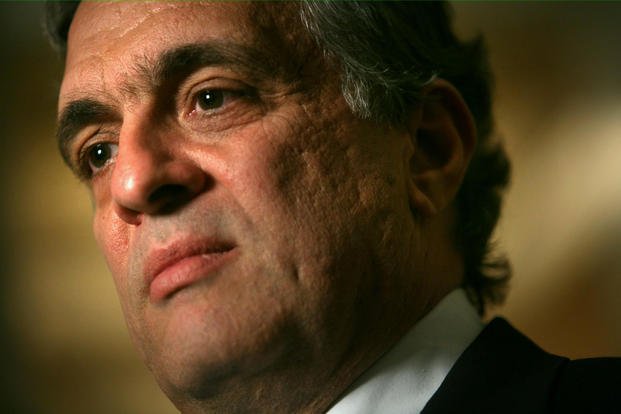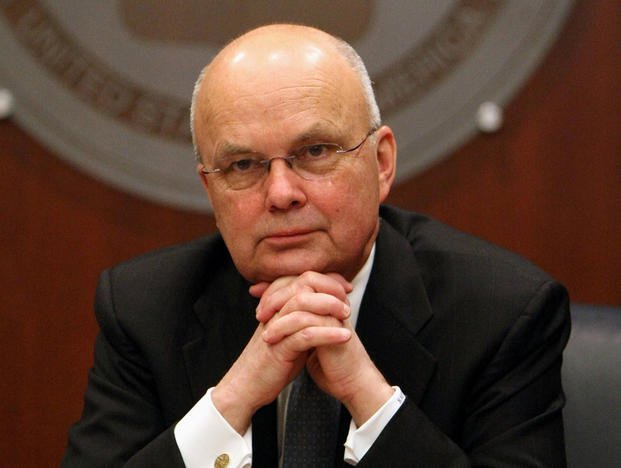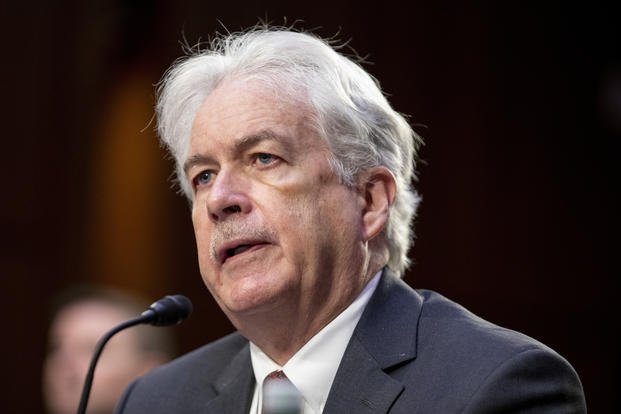Last week in Paris, CIA Director William Burns huddled with Israeli, Egyptian and Qatari officials for the fourth time in three months in an effort to broker a deal for the release of more than 100 hostages being held by Hamas militants in Gaza.
The hostages’ release is a critical component of the Biden administration’s broader diplomatic push to wind down Israel’s military campaign to eradicate Hamas after the Palestinian militants’ brutal Oct. 7 attack that killed 1,200 Israelis and took hundreds hostage. Biden also hopes the release of the hostages also will set the stage for an eventual two-state solution to the Israel-Palestine conflict.
People who know Burns, a former ambassador to Russia and Jordan who rose to the number two spot at the State Department, say he brings a veteran diplomat’s skill set to his role at the CIA, a unique and valuable qualification in dealing with world leaders.
“Intelligence and diplomacy always have been inextricably linked,” Sen. Mark Warner, D-VA, chairman of the Senate Intelligence Committee, told SpyTalk. Citing the CIA director’s 33-year diplomatic career, Warner added: “Bill Burns is uniquely qualified to excel at both intelligence and statecraft. . . he brings unparalleled experience as a former consumer of intelligence to his current job, which allows him to wield the tools of intelligence and diplomacy with unparalleled effectiveness.”
But Burns’ participation in the hostage negotiations is hardly the first time that an American spy chief has taken on a diplomatic mission. Throughout the history of the CIA, several American spymasters or their deputies also have played quiet but critical roles in helping address some of the country’s most complex national security challenges.
Their missions were not always successful, not out of any lack of diplomatic skills but because of the uphill challenges they were entrusted with. During the Trump administration, as tensions mounted between the United States and North Korea, CIA director Mike Pompeo made a top-secret visit in March 2018 to Pyongyang, where he laid the groundwork for a summit between President Trump and North Korean dictator Kim Jong Un to address the growing threat of the North’s nuclear weapons program. For Trump, who valued a good photo-op and headline, the mission was a success. To great fanfare, the two leaders met for the first time several months later in Singapore and then two more times in 2019, but their talks achieved no progress toward denuclearization.
Larry Pfeiffer, who served variously as chief of staff, top policy coordinator and primary advisor to four CIA directors, says presidents turn to their CIA directors and their deputies to tackle thorny foreign policy issues, for a variety of reasons.
“Sometimes the CIA chief is a more trusted interlocutor when the agency’s relationship with a foreign country’s intelligence service remains robust even if diplomatic ties are frayed,” Pfeiffer said in an interview.
Pfeiffer cites the close ties between the CIA and Israel’s Mossad during repeated periods of strained diplomatic ties between several U.S. administrations and Israel’s longest serving prime minister, hardliner Benjamin Netanyahu. Obviously something went haywire last October 7, when Hamas surprised both Israeli intelligence and the CIA with its full scale invasion of Israel, a curious anomaly given the CIA’s long and deep involvement in the Palestinian issue.
In the 1970s, for example, Robert Ames, a CIA operations officer in Beirut and later the agency’s top Middle East analyst, established a close relationship with the Palestine Liberation Organization’s intelligence chief, Ali Hassan Salameh, in the first clandestine contacts with the PLO , then outlawed by the United States as a terrorist organization.
A fluent Arabic speaker and highly respected Middle East expert, Ames regularly briefed President Ronald Reagan on the region and played a major role in drafting Reagan’s 1982 Middle East peace plan, which called for Palestinian autonomy in the West Bank and Gaza under the supervision of Jordan. But during a 1983 visit to Beirut, Ames and 62 others were killed when Hezbollah militants blew up the U.S. embassy.
President Bill Clinton’s CIA Director George Tenet, too, was dispatched to deal with the PLO. In his 2007 memoir, At the Center of the Storm: My Years at the CIA, Tenet recounts how he reluctantly took on an assignment from Clinton in 1996 to get Palestinian leader Yasir Arafat and a deeply distrustful Netanyahu to agree on security arrangements in the wake of a wave of Hamas suicide bombings that killed hundreds of Israelis and brought the Middle East peace process to the brink of collapse.
“To be honest, I wasn’t enamored of suddenly finding myself in the middle of all this,” Tenet wrote. He acknowledged that the CIA was a “natural fit” for the assignment since it already had significant ties to both the Israeli and Palestinian security forces and because agency officials had helped political negotiators resolve other differences.
“But our job in those instances was to provide behind-the-scenes input and insight to the actual negotiators, not to sit at the table ourselves,” he said. “This new plan called for taking on a quasi-diplomatic role in what was largely a political process, and initially that struck me as inappropriate for someone in my position.”
Tenet discreetly shuttled between Israeli leaders and Shin Bet officials in Jerusalem and their Palestinian Authority counterparts in Ramallah, helping narrow their differences. A gifted raconteur, Tenet succeeded in establishing a close relationship with Arafat. During one meeting at the Palestinian leader’s Muqata’a headquarters in Ramallah, Arafat felt comfortable enough to describe his daily exercise routine to Tenet, going so far as to roll up the pants leg of his uniform to show the American spymaster his muscled calves, according to Richard Roth, then the U.S. deputy ambassador in Tel Aviv, who debriefed Tenet after his meetings with Arafat.

Tenet’s shuttle diplomacy set the stage for a major political summit between the two sides in October 1998 at the Wye Plantation Conference Center on Maryland’s Eastern Shore. After six grueling days of shouting, posturing and a theatrical Israeli threat to abandon the summit, Tenet’s bridging proposals, accompanied by his endless coaxing, cajoling and prodding, finally moved both sides to sign the first ever security agreement between Israel and the Palestinians after nearly a century of hostility and violence.
Reflecting on the experience in his memoir, Tenet noted with satisfaction that the security cooperation that the CIA facilitated led to a dramatic drop in terrorist incidents.
“CIA officers were critical to building and opening lines of communication” with the Palestinians, who “were ready to act in a way they had not acted before,” he wrote. Arafat “trusted us,” Tenet added, because, in addition to pushing the Palestinians, he and his CIA team “were also pushing the Israelis.”
“What CIA’s role provided to our government,” he said, “was a basis to help intervene in the coming years, to give the political process the oxygen it needed to keep breathing.”
Alas, that oxygen ran out on September 28, 2000, when Ariel Sharon, the leader of Israel’s opposition rightwing Likud Party, staged a provocative visit to Jerusalem’s Temple Mount, which holds some of the holiest sites in Judaism and Islam, sparking renewed waves of violence that deepened communal hatreds and strengthened Hamas.
Back Channels
Rand Beers, a veteran senior national security official, says presidents also will send their spy chiefs abroad on diplomatic errands when the issue is a security concern that is best handled by a hard-nosed security professional, as opposed to a striped pants diplomat.
“Many CIA directors have been national security professionals who were steeped in the substance of such issues much more than political appointees who might have to depend on their talking points” when dealing with foreign leaders—particularly if those leaders have military or intelligence backgrounds themselves, Beers told SpyTalk.
Michael Hayden military résumé was put to good use after he became CIA director in mid-2006. The former Air Force general and NSA head accompanied Mike O’Connell, the director of national intelligence, to Pakistan in 2008 to urge President Pervez Musharraf, himself a former general, to allow the CIA and U.S. forces more freedom to operate in Pakistan’s Northwest Frontier tribal provinces, which Taliban and al Qaeda militants were using as sanctuary. Musharraf rejected their bid, but the George W. Bush and Obama administrations went ahead and stepped up drone strikes in the provinces.
Hayden also slipped in and out of the Middle East for quiet consultations and arm twisting with U.S. allies in Jordan, Iraq, Egypt, Morocco and beyond.
“We rarely visited Egypt, or anywhere else in the Middle East, without stopping in Saudi Arabia,” he wrote in a 2016 memoir, Playing to the Edge. “When we did, King Abdullah usually made time for us. He had a purpose. Abdullah was passionate about Iran, urging us to ‘cut off the head of the snake’ and warning us to be careful not to ‘lose our aura’ in the region…We had a lot of time for the king. He obviously had time for us.”

Hayden’s trusted deputy Steve Kappes was also deeply involved in secret diplomacy.
In a joint 2003 initiative with Britain’s MI6, Kappes was dispatched on a clandestine mission that successfully convinced Libya’s Muammar Qadaffi to abandon his WMD programs. After secret negotiations with Qadaffi’s intelligence chief Moussa Koussa (who later defected to the U.K.), Libyan terrorist plots also evaporated.
Old Friends
Another reason why presidents turn to their CIA directors for sensitive diplomatic missions is because they’ve forged trusted personal relationships with them over the years.
“The head of intelligence could be a trusted personal adviser of the president, someone who is closer to the president than the secretary of state or defense,” Pfeiffer says,
One of the best examples of this kind of relationship is the one forged between President Richard Nixon and General Vernon Walters, a legendary figure who grew up in Europe as the son of an American businessman and spoke French, Spanish, Italian and German with native fluency by the time he was 10 years old. He later mastered Portuguese, Greek and Russian. A veteran of World War II, he served as a military attache, interpreter, special envoy and confidant to every cold War president save Jimmy Carter.
But it was Walter’s close relationship with Nixon that led to his appointment as deputy CIA director in 1972. Walters had accompanied Vice President Nixon to Venezuela on a goodwill tour in 1958 as his interpreter when a mob attacked their limousine, smashing its windows and nearly pulling both of them from the vehicle. Every year afterward on May 13, the two would meet, or at least talk to celebrate their survival.
Before he went to the CIA, Water served as the defense attache in Paris, where Nixon relied on him to secretly smuggle national security adviser Henry Kissinger in and out of the city for talks with Chinese officials that eventually led to the president’s historic visit to China. He did the same for Kissinger’s secret talks with North Vietnamese officials, On Nixon’s orders, Walters kept Kissinger’s visits highly secret, telling no one.
Walter’s subsequent appointment as deputy CIA director did not please the agency’s boss, Richard Helms, who suspected Nixon had planted Walters at the agency to spy on him. “I know you speak a lot of foreign languages, but what is your experience in intelligence?” Helms asked Waters, according to an authoritative account by CIA historian Benjamin Fischer. Walters replied: “I’ve been negotiating with the Chinese and Vietnamese in Paris without you or anybody in this Agency knowing anything about it.”
In 1973, after PLO terrorists murdered the U.S. ambassador to Sudan and a second American diplomat in Khartoum, Nixon and Kissinger ordered Walters to meet with the Palestinians and warn them to stop killing Americans. Walters turned to an old friend, Morocco’s King Hassan II. In 1942, while serving as an Army intelligence officer in Morocco after the Allied invasion of North Africa, Walters had given Hassan, then a 13-year-old prince, a ride on an American tank, an experience the king never forgot.
King Hassan agreed to set up the meeting with the PLO officials, and Walters flew to Morocco.
“The King took me in, and there were three of them, and I was alone,” Walter’s account continued. “I said to them, ‘Something dreadful will happen if you do not stop. I cannot go into the details of it, but you may expect the direst of reprisals.’ I figured that was as far as I could go legally.”
CIA historian Fischer credits Walters with saving the CIA from disgrace during the Watergate scandal by refusing to obey White House orders to pay the bail and bribes for the Watergate burglars from the CIA’s cache of unvouchered funds.
Walters left the CIA in 1976 after the election of Carter. But President Ronald Reagan brought him back into service as a special presidential envoy to carry out sensitive diplomatic missions all over the world. According to Fischer, outside of the CIA and the White House, few people were aware that Walters successfully rescued three CIA officers who had been kidnapped and held as hostages in separate incidents in African countries during the Reagan years.
Moscow Nights
The recurring issue of hostage-taking brings us back to Burns, whose trip to Paris last week is only his latest diplomatic errand since Biden appointed him as CIA director upon taking office in January 2021.
After the Taliban’s defeat of the U.S. backed Afghan government in August of that year, Burns quietly traveled to Kabul to discuss the safe withdrawal of U.S. forces from the country with the leaders of the new Taliban government, which the United States refused to recognize. “Sometimes, it’s more convenient for intelligence officers to deal with historic enemies in situations in which diplomatic contact might connote formal recognition,” Burns explained in a recent article in Foreign Affairs.
In November 2021, Burns flew to Moscow in an unsuccessful effort to convince President Valdimir Putin not to invade Ukraine. While Putin denied his intention to invade, Burns was a strong proponent for the declassification and release of U.S. intelligence showing the Russian military buildup on Ukraine’s border, which the Biden administration cited to correctly predict the invasion. The CIA stumbled, however, in its prediction that Russian forces would defeat Ukraine’s military in a matter of weeks.
On another diplomatic errand in April 2022, Burns flew to Saudi Arabia on Biden’s orders to offer an olive branch to Crown Prince Mohammed bin Sultan after Biden had declared the kingdom’s de facto ruler a pariah over his involvement in the murder of Saudi journalist Jamal Khashoggi.
Today, Burns' effort to win the release of the Gaza hostages could be his most difficult challenge so far, especially now that the conflict has spread across the region to Iraq, Lebanon, Jordan, Syria and Yemen, with U.S.and U.K. air strikes targeting Iran-backed militias in those countries.
But even in such a supercharged political climate, a CIA director has an advantage over a diplomat, says Beers.
“When the CIA director walks into a meeting, he’s generally talking to somebody with whom he can have a confidential, nonpolitical discussion about a political issue,” Beers said in an interview. “It allows all sides to put things on the table and have a more candid conversation that can lead to a solution.”
SpyTalk Editor-in-Chief Jeff Stein contributed reporting to this story.
This article first appeared on Spytalk.co.











